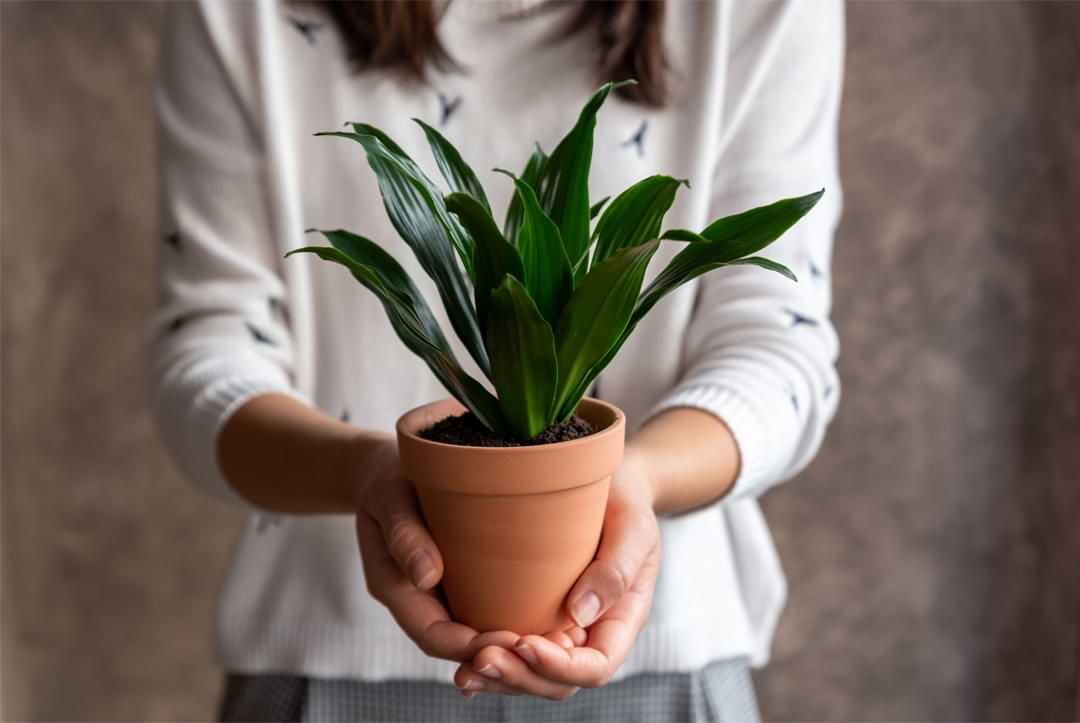Dracaena varieties are classic indoor trees for a reason! They’re drought-resistant, tolerant of lower light, and don’t need a lot of humidity. They’re a staple in office environments and they add a touch of whimsy to our homes with their signature spiky leaves and slender trunks. These trees also grow slowly, which makes them perfect for indoor settings because they aren’t likely to outgrow their environment.
Which type of dracaena is right for you? Let’s look at some different dracaena varieties, their key features, and how to care for them once you’ve chosen the dracaena of your dreams.
Table of Contents
- Dracaena Varieties
- Madagascar Dragon Tree (Dracaena Marginata)
- Song of India (Dracaena Reflexa)
- Corn Plant (Dracaena Fragrans)
- Canary Island Dragon Tree (Dracaena Draco)
- Striped Dracaena (Dracaena Warneckii)
- Lucky Bamboo (Dracaena sanderiana)
- Florida Beauty (Dracaena surculosa)
- Janet Craig (Dracaena deremensis)
- Dracaena Care
Dracaena Varieties
Madagascar Dragon Tree (Dracaena Marginata)
This may be the most popular dracaena variety and is the one you’re probably used to seeing most frequently. This variety has very thin, straplike leaves and a skinny trunk. They look like something out of a Dr. Seuss book! The leaves also come in a few different colors such as magenta or tricolor.
These trees grow very slowly and may take more than 5 years to reach their maximum indoor height of 5-6 feet. This tree prefers bright, indirect sunlight but will be fine in lower light.
Read our full care guide on dracaena marginata here.
Song of India (Dracaena Reflexa)
Also called Song of Jamaica, this beautiful dracaena is known for its distinctive yellow or cream and green striped leaves that grow in starlike clusters all over the tree. This variety can sometimes produce small flowers and is drought-resistant, but it does like a bit more humidity and indirect light than some other types of dracaena. This variety tends to be a bit on the bushy side.
Corn Plant (Dracaena Fragrans)
This variety earned its nickname from its long, curved, dark- and light-green leaves that slightly resemble the leaves of corn stalks. They almost look like mini palm trees with their sturdy trunks and crown of splayed leaves! You’ll often find these plants potted in tiered groups of three in most home and garden stores.
This tree can reach up to 6 feet indoors and does well in lower light.
Canary Island Dragon Tree (Dracaena Draco)
There are actually several species of dracaena called dragon tree, but this one actually has draco, the Latin word for “dragon,” in the name! It has thick, snaky, aloe-like leaves. And like aloe and other succulents, this tree is hardy and doesn’t require much water. In fact, the best way to care for this tree is to treat it like a succulent and provide it with bright light and well-draining soil.
Striped Dracaena (Dracaena Warneckii)
This variety sports pointed, striped dark-green leaves and grows in a bushier, more shrublike formation than some of the other dracaena varieties. This plant likes lower light than some of the other varieties, but otherwise, the care is the same as other dracaenas.
Lucky Bamboo (Dracaena sanderiana)
Surprise! You’ve almost definitely seen this plant before (and may even own one), but you might not have known it was actually a species of dracaena—and not a bamboo at all!
These plants only reach a foot or so in height. You can train this plant to grow in shapes like a spiral, or even braid them.
You’ll most often see these plants in water and possibly gravel or colored marbles, but you can also plant them in soil. In fact, they will most likely live longer that way. If you do choose to grow this plant in water, change the water every week. If you plant it in soil, keep the soil slightly damp and water when the top few inches are dry. Simple!
Florida Beauty (Dracaena surculosa)
This variegated dracaena is unusual because instead of displaying colored stripes like most variegated dracaenas, this plant has dark-green leaves with cream-colored spots. This is also called the Gold Dust Plant or Spotted Dracaena.
Care is the same as other dracaenas, though this variety prefers more humidity than your typical dracaena. It can tolerate low light, but you’ll see more variegation with bright, indirect sunlight.
Janet Craig (Dracaena deremensis)
This variety has long, pointed, dark-green leaves and is often used as a filler plant for indoor planters in malls and offices. You’ll usually see Janet Craig in a planter on the floor or a table with 3-5 stalks in each pot to give it a bushier appearance. This plant does very well in lower light. Never place this plant in direct sunlight even for a few minutes, or you might have a pile of burned leaves on your hands!
Dracaena Care
Most dracaena varieties prefer similar care. They like bright, indirect sunlight but do well in low light. They are drought-tolerant, so make sure to let the top half of the soil dry completely before watering with distilled water, because they are sensitive to the chlorine in most tap water. Most varieties don’t require much humidity and can tolerate a range of temperatures.




